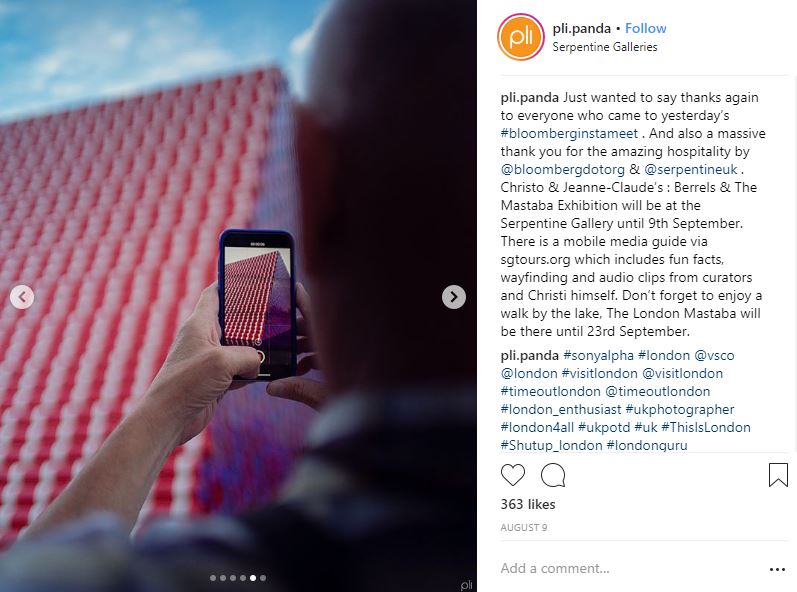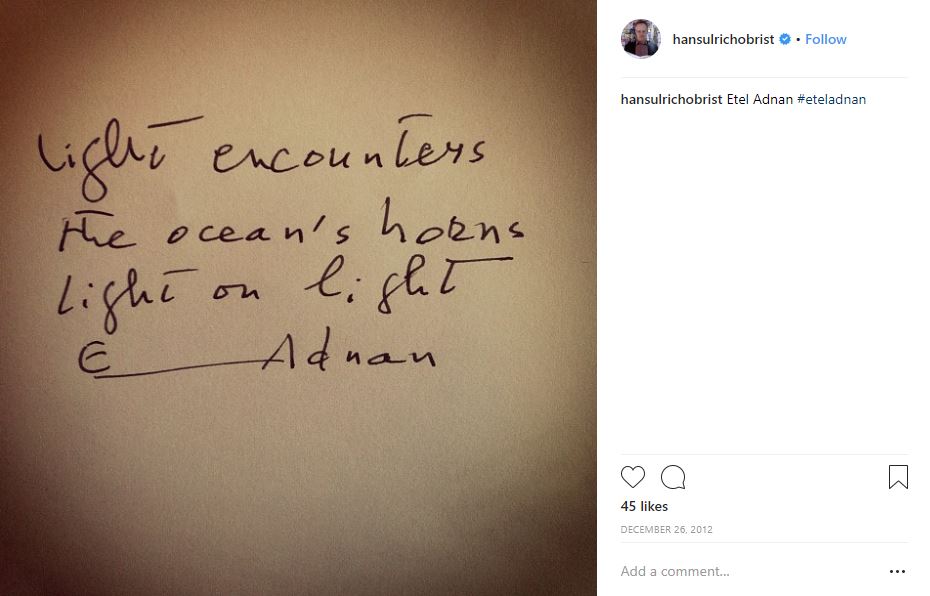Instagram and the Arts – An Invitation to Explore

By Hans Ulrich Obrist, Artistic Director of the Serpentine Galleries
Thanks to our beautiful location in Hyde Park and Kensington Gardens, the Serpentine is never busier than during the summer months. If you’re not in London right now, you need only check social media, where visitors to our two galleries have been sharing images of their encounters with art and architecture in the heart – and heat – of the city.
The 25 outstanding paintings of Turner prize-winning artist Tomma Abts’s exhibition nearly all measure a neat 48cm x 38cm, but that hasn’t stopped people posting them to the squares of their Instagram grid. And Lee Ufan’s amazing sculpture on our grounds, Relatum – Stage, has also become a ‘selfie machine’.
This month, too, we hosted a #BloombergInstameet for The London Mastaba, Christo and Jeanne-Claude’s monumental sculpture on the Serpentine Lake and accompanying exhibition, as well as the Serpentine Pavilion by Frida Escobedo of Mexico City, the youngest architect yet to design our annual commission, which began with Zaha Hadid in 2000.

Why gather Instagrammers in real time, you ask? Surely everyone is heads-down in their smartphone, trying to grab the perfect shot to secure maximum ‘likes’ and comments.
For me, the potential of Instagram is not in chasing trends. It started out as a curatorial platform for a very specific project. I had been thinking hard about the loss of the manuscript from modern life, ever since meeting the author Umberto Eco, not long before he died. Eco had observed to me that handwriting is disappearing in this digital age (or, as the journalist Elizabeth Kolbert calls it, the age of mass extinction). Then one night, soon after, I was out for dinner with the Lebanese writer and artist, Etel Adnan, when she passed me a poem that she had written on a napkin.

This was the genesis of my Handwriting Project, in which I ask every artist I meet to write something by hand on a Post-It Note, which I then post to my Instagram account. Paradoxically, it’s a mean of reviving the handwriting that is slowly disappearing through our use of digital media. The project may yet come full circle and become a book.
I also look to Instagram as a research tool for insights into the practice of artists. Their feeds can be a fascinating window into their thought processes and sometimes a door into their studios as well. At the Serpentine, we often invite the artists we work with to ‘take over’ our Instagram feed, @serpentineUK. Torbjørn Rødland shared his photographs of installing the 2017 exhibition, The Touch That Made You, while artist Victoria Sin posted images ahead of their mesmerizing drag performance in Escobedo’s Pavilion for Park Nights 2018.
Not only is Instagram a means of seeing shows you can’t get to, it also allows you to take art everywhere you go. As someone who travels a great deal for my work, I find this a huge advantage. Art is both created and exhibited in this virtual space. However, I believe that museums and galleries are more important than ever in this context, due to the mass amnesia we suffer from in a digital age. The overload of information available online is not necessarily synonymous with memory or explanation. As the late artist Gustav Metzger once told me, art must be a protest against forgetting.
So we were very happy to welcome new and returning visitors to the Instameet, organized by Bloomberg Philanthropies as part of the Bloomberg Connects program supporting our digital engagement and Mobile Tours. Read or listen to artists talk more about their work or commune directly with their art – it’s up to you. As Christo says of the 7,506 colored barrels that make up The London Mastaba: “all interpretations welcome”.
Each Instagrammer at the meet saw our art and architecture differently and those individual takes – and images – will reach an audience far beyond those able to visit the park. Just as crucial was the experience we had, together, in this particular place on that particular night. Similarly, Frida Escobedo talks about architecture’s dual qualities of time and space. Her Pavilion is site-specific to the Serpentine lawn this summer. But, aligned to the Prime Meridian (the global marker of time and distance) and subtly mixing Mexican and British influences, it is also a timepiece and compass that allows us to locate ourselves in the wider world.
Digital media can richly amplify the experience of the art gallery or museum, but it will never replace it. In a digital age, we long for shared experiences.
Hans Ulrich Obrist is an art curator, critic and historian of art. He is artistic director at the Serpentine Galleries, London.
